12 Small Changes That Prevent Big Dental Problems | Expert Prevention Tips
You notice it when you open your mouth: a child’s tooth with an odd brown edge, gums that bleed when you floss, or a dark patch on a molar. These are fairly common dental issues that can become expensive if left untreated.
The CDC reports that 92% of adults aged 20–64 have had at least one cavity (see common dental checkup signs), and nearly half of adults over 30 show signs of gum disease. The good news? 90% of dental problems and solutions are preventable with daily habits, not expensive procedures.
It takes less than ten minutes a day to make these twelve minor adjustments. They work for both adults and children, target the root causes of dental issues, and prevent symptoms early.
Let’s begin.
The Hidden Cost of Ignoring Dental Problems
Dental problems affect more than your smile. Untreated gum disease is linked to heart disease (American Heart Association, 2024). Enamel erosion leads to sensitivity and higher treatment costs. Early detection saves money: a filling averages $150–$300; a root canal exceeds $1,000 (ADA 2025 fee survey).
Common Dental Problems and Their Warning Signs
Problem | Dental Problems Symptoms | Long-Term Risk |
Cavities | Dark spots, sensitivity to sweets/cold | Root canal, tooth loss |
Gum Disease | Bleeding gums, bad breath, swelling | Tooth loss, heart disease link |
Enamel Erosion | Yellowing, translucency, and pain with temperature | Crowns, veneers ($800–$2,500) |
Oral Cancer | White/red patches, non-healing sores | 57% 5-year survival if late-stage |
Learn more about early gum disease warning signs and treatments.
Causes of Dental Problems (Backed by Research)
- Plaque Hardens into tartar in 24-48 hours (Journal of Clinical Periodontology)
- Acid Exposure pH drops below 5.5 within 60 seconds of eating sugar/acid (Caries Research)
- Reduced Saliva Common with 400+ medications; increases decay risk 3x (JADA 2023). Explore causes of dry mouth and natural solutions to keep your mouth hydrated and healthy.
- Missed Checkups 42% of adults skip annual visits (CDC 2024)
Dental problems and prevention begin at home. These 12 changes are proven, practical, and effective.
Your 12 Small Changes: Science-Backed Prevention
1. Brush for Two Full Minutes with Fluoride Toothpaste
The average brushing time is only about 45 seconds, which is less than half of what your teeth actually require, despite the fact that most people believe they brush for long enough. According to Cochrane Oral Health, brushing for the full two minutes can remove up to 60% more plaque (2023). Your toothbrush bristles can reach areas that are frequently overlooked, particularly along the gum line and the back molars, thanks to the additional time.
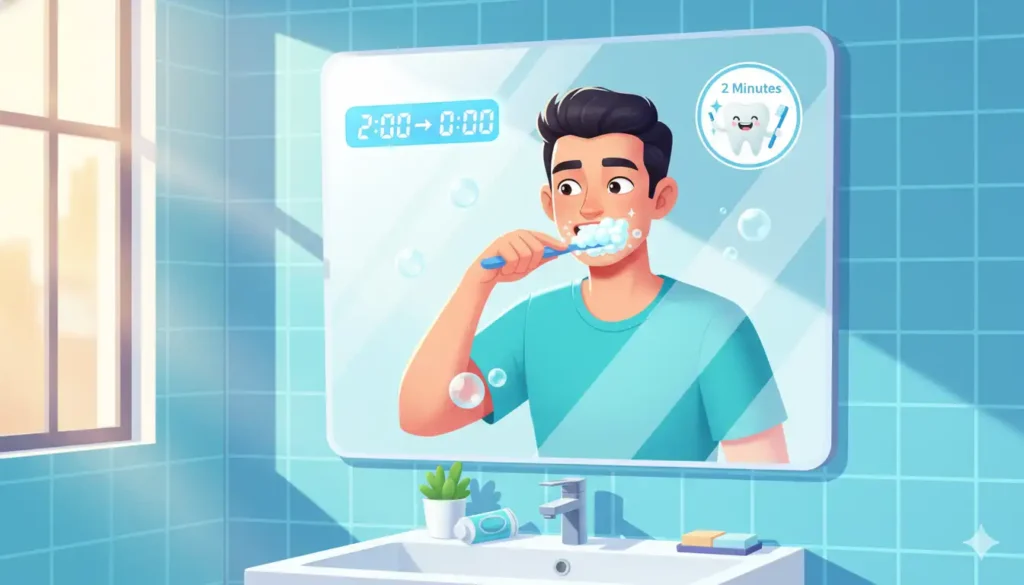
By fortifying your enamel and increasing its resistance to acid attacks and early decay by up to 20–40%, fluoride toothpaste provides an additional layer of defense. This easy practice can eventually help avoid early indications of gum inflammation and white spot lesions.
⏱ 2 minutes | 💡 Pro Tip: Set a timer, play your favorite short song, or switch to an electric toothbrush with a built-in timer to make sure you’re giving your teeth the full two-minute treatment every time.
Over time, this simple habit can help prevent white spot lesions and early signs of gum inflammation. Learn more about white spots on teeth causes and treatment.
2. Floss Before Brushing
This little adjustment has a big impact: floss before brushing. First, flossing makes it easier for toothpaste and fluoride to get to those hard-to-reach areas by loosening and removing food particles and plaque that have become lodged between your teeth. This easy change can reduce plaque by up to 40% more than brushing alone, according to the Journal of the American Dental Association (2022).
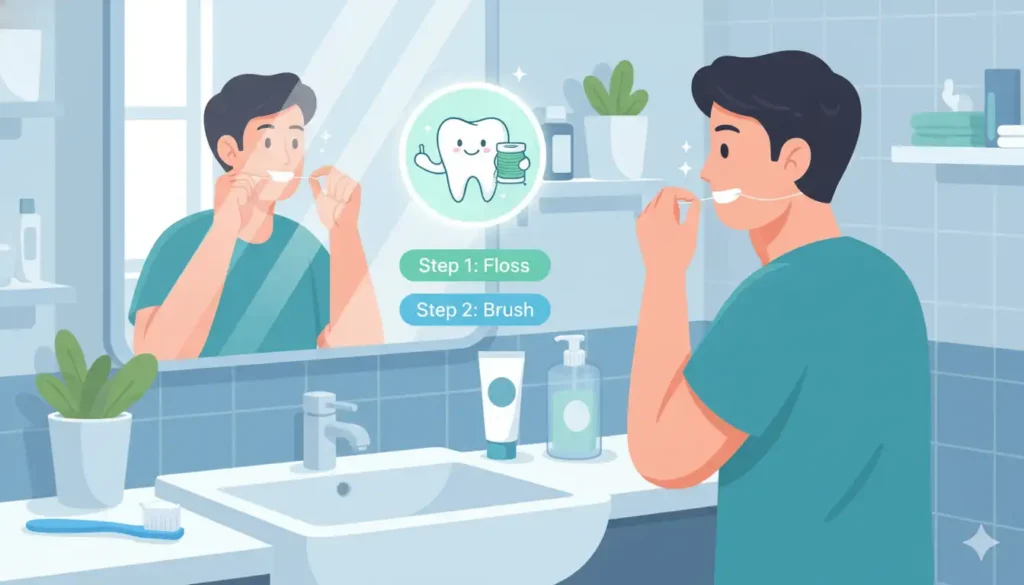
Flossing targets the spaces between teeth, where almost 60% of cavities start, that are inaccessible to a toothbrush. Including it in your daily routine helps prevent interproximal decay, which is the sneaky kind that lurks between teeth, and maintains the health of your gums.
⏱ 1 minute | 💡 Pro Tip: If traditional floss feels tricky to handle, try using floss picks, interdental brushes, or a water flosser. The key is consistency, not perfection.
3. Scrape Your Tongue Every Morning
In addition to aiding in taste, your tongue harbors a startling number of bacteria. According to the International Journal of Dental Hygiene, approximately 75% of the bacteria that cause bad breath reside on its surface. You occasionally notice that white or yellowish coating? It is a mixture of dead cells, microbes, and food scraps.
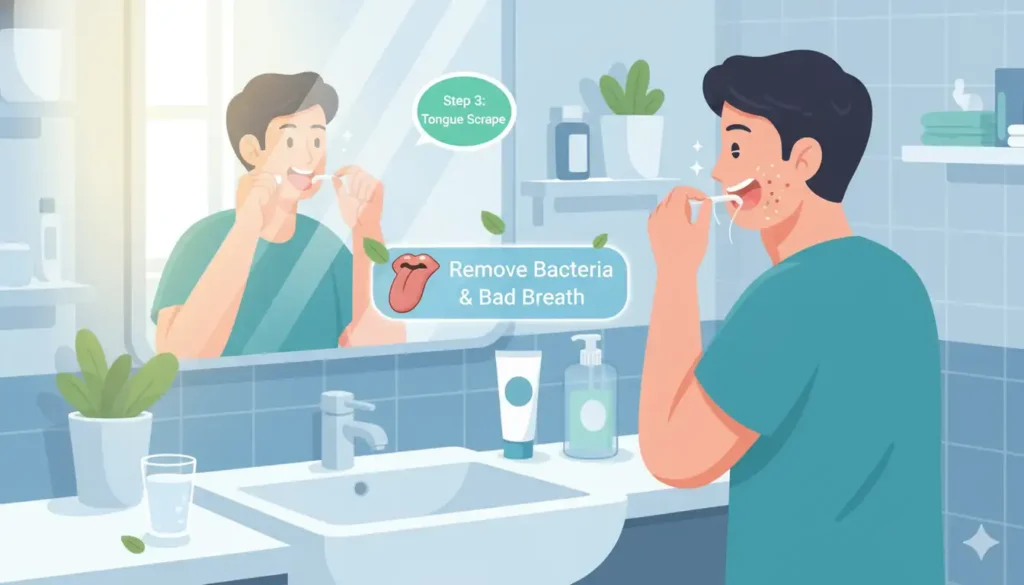
You can cut down on the gases that cause bad breath, known as volatile sulfur compounds, by up to 70% by gently scraping your tongue every morning. It’s among the simplest and best methods to promote general oral health and freshen your breath. Additionally, maintaining a clean tongue reduces the amount of bacteria that gets transferred to your teeth and gums.
⏱ 10 seconds | 💡 Pro Tip: Use a plastic or stainless steel tongue scraper and glide it gently from the back of your tongue toward the front. Do it once or twice, that’s all it takes to start your day feeling fresh.
4. Rinse with Alcohol-Free Fluoride Mouthwash at Night
One of the easiest ways to strengthen your teeth while you sleep is to give them a quick fluoride rinse before bed. Cochrane (2021) claims that using a mouthwash containing fluoride can cut adult tooth decay by up to 25%. Because your saliva production naturally decreases by roughly 50% while you sleep, making your teeth more susceptible to acid attacks, using it at night is the most effective time to use it.
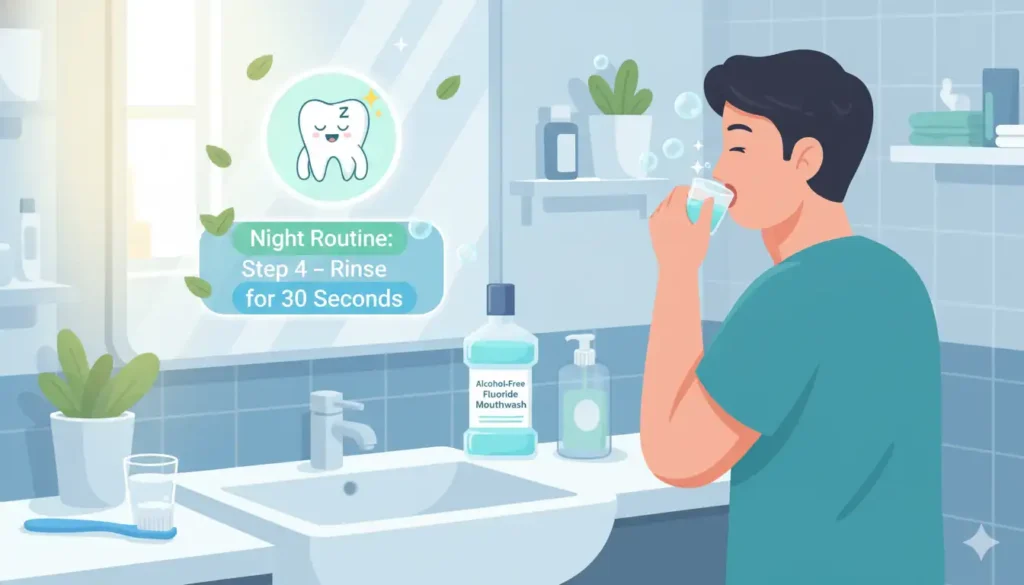
Since it won’t dry out your mouth or irritate delicate tissues, an alcohol-free formula is best. This tiny action helps guard against early enamel wear, sensitivity, and the early, sometimes undetectable symptoms of decay.
⏱ 30 seconds | 💡 Pro Tip: After rinsing, avoid eating or drinking for at least 30 minutes to let the fluoride fully absorb and strengthen your enamel.
5. Drink Water After Every Meal or Snack
Drinking water after meals is one of the simplest and most neglected oral hygiene practices. Acids produced by the bacteria in your mouth after each meal or snack cause your pH to drop, which weakens your enamel. The pH of your mouth can return to neutral in just 60 seconds by rinsing it with water, according to the Archives of Oral Biology.
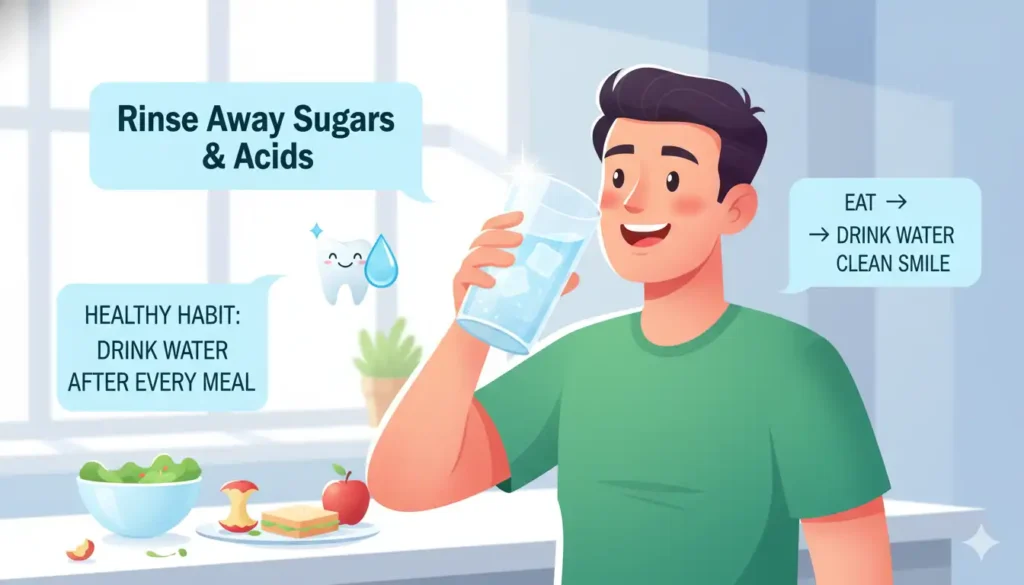
That quick drink helps wash away leftover food particles and sugars that bacteria feed on, in addition to balancing acids. This easy routine prevents demineralization of your enamel and lessens plaque accumulation over time.
⏱ 10 seconds | 💡 Pro Tip: Keep a reusable water bottle nearby and take a few sips after every meal or snack. It’s the fastest, easiest way to give your teeth a mini-clean between brushes.
Explore more tooth-friendly habits in our article on the best and worst foods for better teeth.
6. Replace One Sugary Drink with Sparkling Water + Lemon
Reducing consumption of sugar-filled beverages does not have to mean sacrificing flavor. You can significantly improve the condition of your teeth by substituting sparkling water with a slice of lemon for one soda or other sweetened beverage per day. Streptococcus mutans, the bacteria that produce acid and attack your enamel for up to half an hour after you finish drinking, are fed by the roughly 10 teaspoons of sugar in a 12-ounce can of soda.
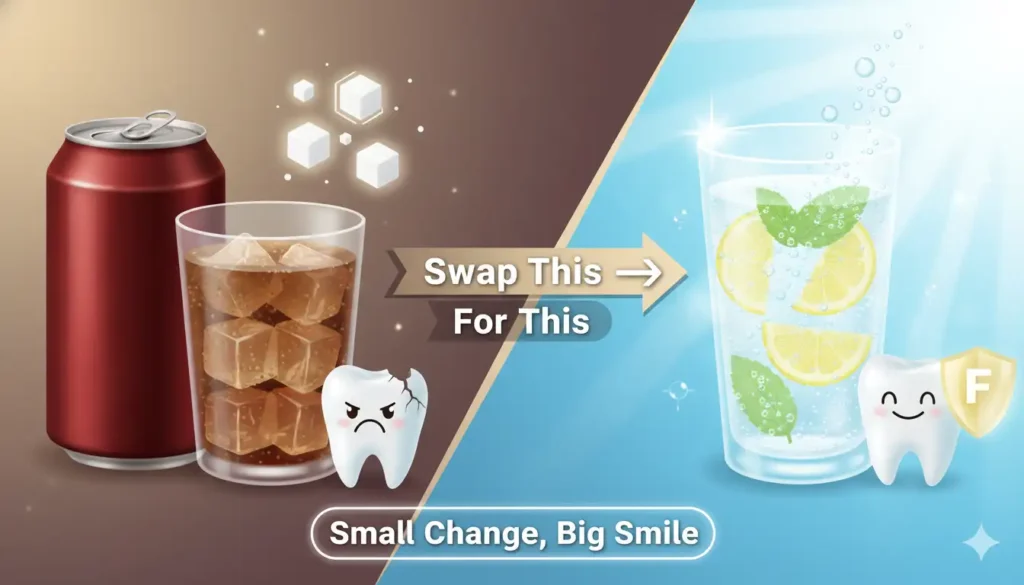
You can totally disrupt that acid-sugar cycle by substituting sparkling water. You won’t have to worry about damaging bacteria or discoloring your teeth to enjoy the cool taste and fizz. This easy change promotes stronger enamel and a whiter smile over time.
⏱ 0 minutes | 💡 Pro Tip: Keep a reusable bottle on hand and experiment with slices of lemon, cucumber, or berries for a flavorful, eco-friendly upgrade.
7. Eat Crunchy Vegetables as a Snack
Crunchy veggies like carrots, celery, and cucumbers do more than just sate your midday hunger; your teeth love a good crunch. According to the Journal of Dental Research, chewing these foods high in fiber increases saliva flow by almost 300%. The fibrous texture gently scrubs the surfaces of your teeth like a natural toothbrush, and the excess saliva naturally removes food particles and acids.

A quick and easy method to improve your oral hygiene, lessen plaque, and freshen your mouth in between meals is to swap out processed snacks for crunchy vegetables. It’s a minor practice that promotes general and dental health.
⏱ 2 minutes | 💡 Pro Tip: Wash, cut, and pre-portion your veggies into small containers or zip bags, so you can grab a healthy, tooth-friendly snack anytime you need one.
8. Chew Xylitol Gum for 5 Minutes After Eating
Chewing gum that contains xylitol is a scientifically proven method of protecting your teeth, so it’s not just a breath-freshening trick. Xylitol can reduce Streptococcus mutans, the bacteria that cause cavities, by up to 70%, according to research published in Caries Research (2023). Additionally, it increases saliva production by up to ten times, which aids in neutralizing acids and removing food particles after meals.
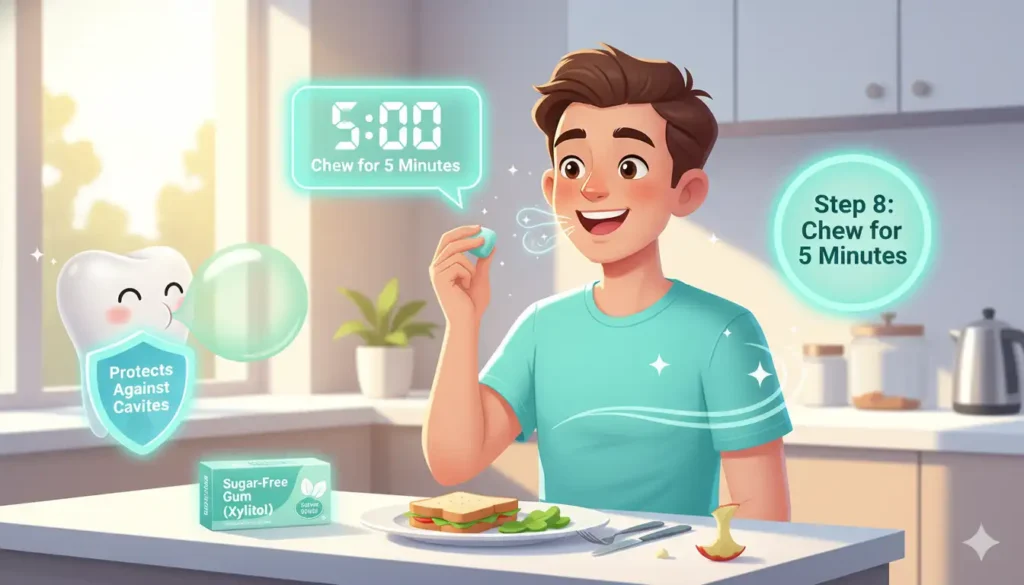
Just five minutes of chewing xylitol gum can help stop the acid attacks that occur after meals, which erode enamel and cause decay. Additionally, the increased saliva keeps your mouth’s pH balance in a healthy range.
⏱ 5 minutes | 💡 Pro Tip: Always check the label, look for gum that contains 100% xylitol as the sweetener. It’s the key ingredient that makes this habit truly effective.
9. Use an Electric Toothbrush Once Daily
If you haven’t tried an electric toothbrush yet, this is your sign to switch. According to a Cochrane (2023) review, electric toothbrushes remove 21% more plaque and reduce gingivitis by 11% compared to manual brushing. The powered motion and consistent pressure help clean areas that are often missed, especially behind the molars and along the gumline.
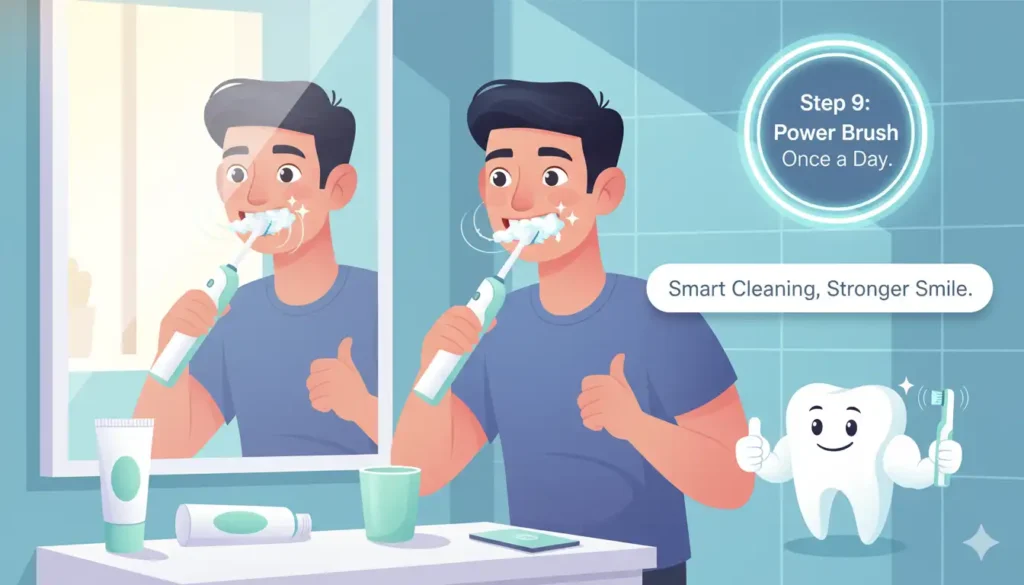
Using an electric brush once a day can make a visible difference in your oral health, reducing your risk of back tooth decay and gum recession. It’s especially beneficial for people who brush too hard or rush through their routine.
⏱ 2 minutes | 💡 Pro Tip: Replace your brush head every 3 months or sooner if the bristles start to fray; worn bristles don’t clean as effectively.
10. Schedule 6-Month Checkups
No matter how consistent your home care routine is, professional cleanings are essential. Dentists and hygienists use specialized tools to remove tartar, the hardened plaque that brushing and flossing can’t eliminate. These regular visits also allow your dentist to spot early signs of decay, gum disease, or other issues long before they become painful or expensive to treat. Combine these with a morning routine for healthy gums for lasting oral freshness.
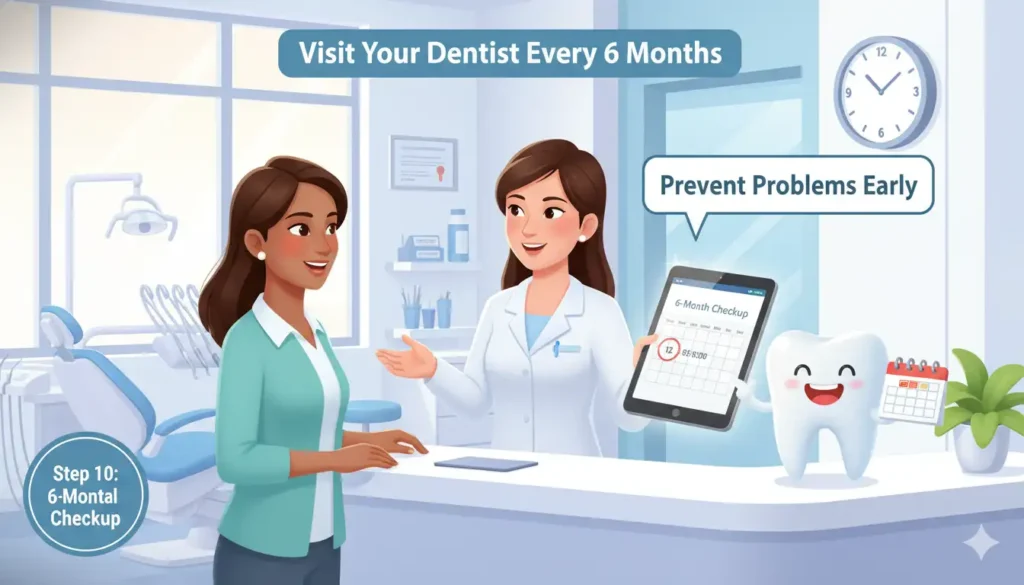
According to the American Dental Association (2025), early detection can prevent up to 80% of advanced dental treatments. That means fewer surprises, less discomfort, and lower long-term costs for your oral health.
⏱ 5 minutes to book | 💡 Pro Tip: Set a recurring calendar reminder for every six months so you never miss a checkup, your future self (and your smile) will thank you.
If you’re overdue for an exam, learn about the step-by-step dental cleaning process.
11. Wear a Nightguard if You Grind
If you wake up with jaw tension or notice small chips on your teeth, you might be grinding at night, a condition known as bruxism. It’s more common than you think and can wear down enamel up to 10 times faster than normal chewing, according to the Journal of Prosthetic Dentistry. Over time, grinding can cause cracked teeth, headaches, and even jaw joint pain.
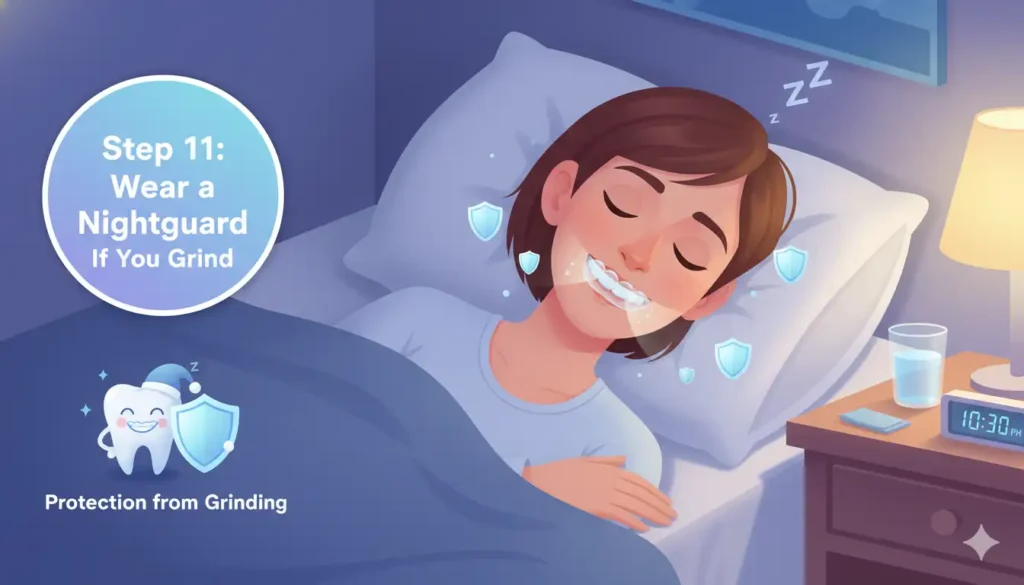
Wearing a nightguard acts like a cushion between your upper and lower teeth, absorbing the pressure and preventing damage. Research shows that a properly fitted guard can reduce the risk of tooth fractures by as much as 85%.
⏱ 10 seconds | 💡 Pro Tip: Over-the-counter boil-and-bite guards work well as a short-term fix, but if you grind heavily or frequently, consider asking your dentist for a custom-fit guard for maximum comfort and protection.Lorem ipsum dolor sit amet, consectetur adipiscing elit. Ut elit tellus, luctus nec ullamcorper mattis, pulvinar dapibus leo.
12. Self-Exam Your Mouth Monthly
Early detection saves lives, literally. The American Cancer Society (2025) reports a 90% five-year survival rate for oral cancer when caught early, compared to just 57% when detected late. A one-minute monthly self-check can make all the difference.
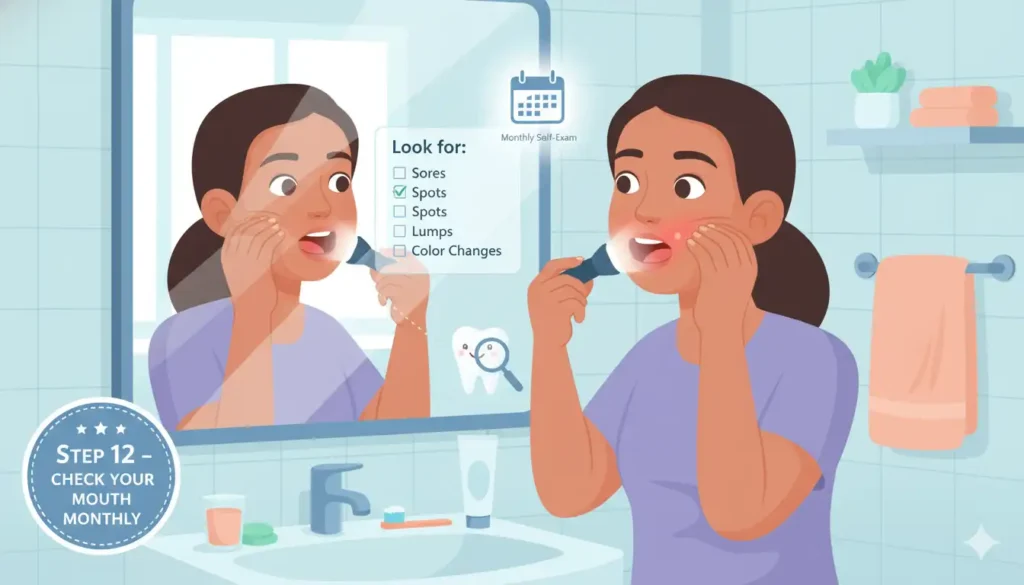
Grab a flashlight and mirror, then inspect your gums, tongue, cheeks, and the roof and floor of your mouth. Look for any non-healing sores, white or red patches, or unusual lumps.
⏱ 1 minute | 💡 Pro Tip: Do your self-exam on the 1st of every month so it becomes part of your regular routine.
Dental Problems in Children: Evidence-Based Protection
Did you know that 42% of children aged 2–11 develop cavities in their baby teeth (CDC, 2024)? See our full guide on causes and treatments for kids’ cavities for practical prevention steps. The good news, most of these issues are completely preventable with a few simple, science-backed habits.
Start early:
- Wipe your baby’s gums with a clean, damp cloth after each feeding. This gentle habit minimizes bacterial buildup before teeth even erupt.
- Introduce straw cups by age 1. They help reduce prolonged contact between sugary or acidic liquids and your child’s teeth.
- Limit juice intake to 4 oz per day (AAP, 2023). Too much sugar creates the perfect environment for decay-causing bacteria.
Excess sugar fuels the bacteria that cause tooth decay, especially in children. Many everyday snacks and drinks contain hidden sugars in kids’ foods you might not expect. By limiting them and building small daily habits, you can help your child maintain a strong, cavity-free smile that lasts a lifetime.
FAQs
1. What are the most common dental problems?
Cavities (92% of adults, CDC 2024), gum disease (47% of adults over 30), enamel erosion, and bad breath. Most start with plaque buildup.
2. How can I prevent dental problems at home?
Brush 2 minutes with fluoride (#1), floss before brushing (#2), rinse with fluoride mouthwash (#4), and drink water after meals (#5). These stop 90% of preventable dental problems (ADA 2025).
3. What causes bleeding gums when brushing?
Gingivitis from plaque buildup along the gumline. It’s reversible in 1–2 weeks with proper removal.
4. Can dental problems be prevented naturally?
Yes, 80–90% with habits, not products. Crunchy veggies (#7), xylitol gum (#8), and water rinses (#5) reduce bacteria and acid naturally. Fluoride is still the gold standard (25% decay reduction, Cochrane 2021).
5. Is mouthwash necessary to prevent dental problems?
Alcohol-free fluoride mouthwash adds 25% extra decay protection (Cochrane). Not required, but #4 (night rinse) strengthens enamel while you sleep.

Dr. Alexander Heifitz (Author)
Dr. Alexander Heifitz is the founder of 65 Broadway Dental in NYC, where he combines advanced dental expertise with a patient-first approach. He specializes in cosmetic and restorative treatments such as dental implants, veneers, Invisalign, and smile makeovers, helping New Yorkers achieve both oral health and confidence.
Booking An Appointment
Looking for a reliable dentist in Downtown NYC? Whether you need a routine cleaning, urgent care, or a full smile transformation — we’ve got you covered. We accept most PPO insurance plans and offer flexible scheduling.
+1 (212) 430-3888
Call for appointment
Walk-ins Welcome / Same-Day Appointments Available

Related Blogs
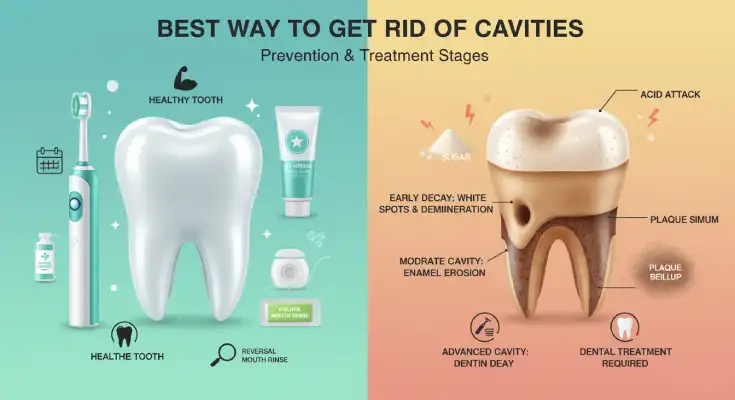
The Best Way to Get Rid of Cavities: What Actually Works (Backed by Science)
Discover the best way to get rid of cavities with proven science-backed methods, daily care tips, and dentist-recommended strategies.
Read More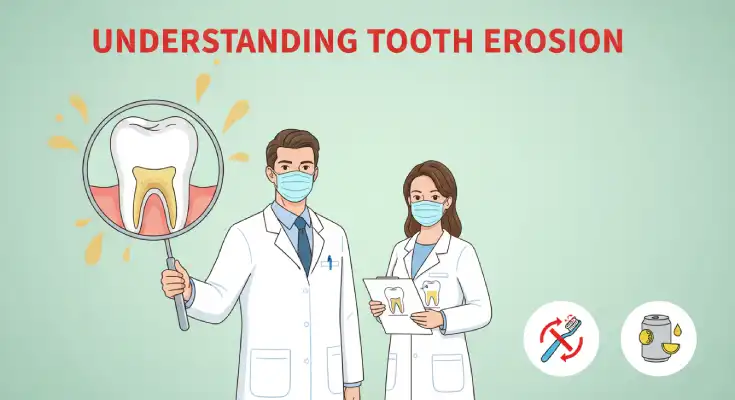
Tooth Erosion at the Gum Line: Causes, Treatment & Prevention
Learn what causes tooth erosion at the gum line, how dentists treat it, and simple ways to protect your enamel from further damage.
Read More